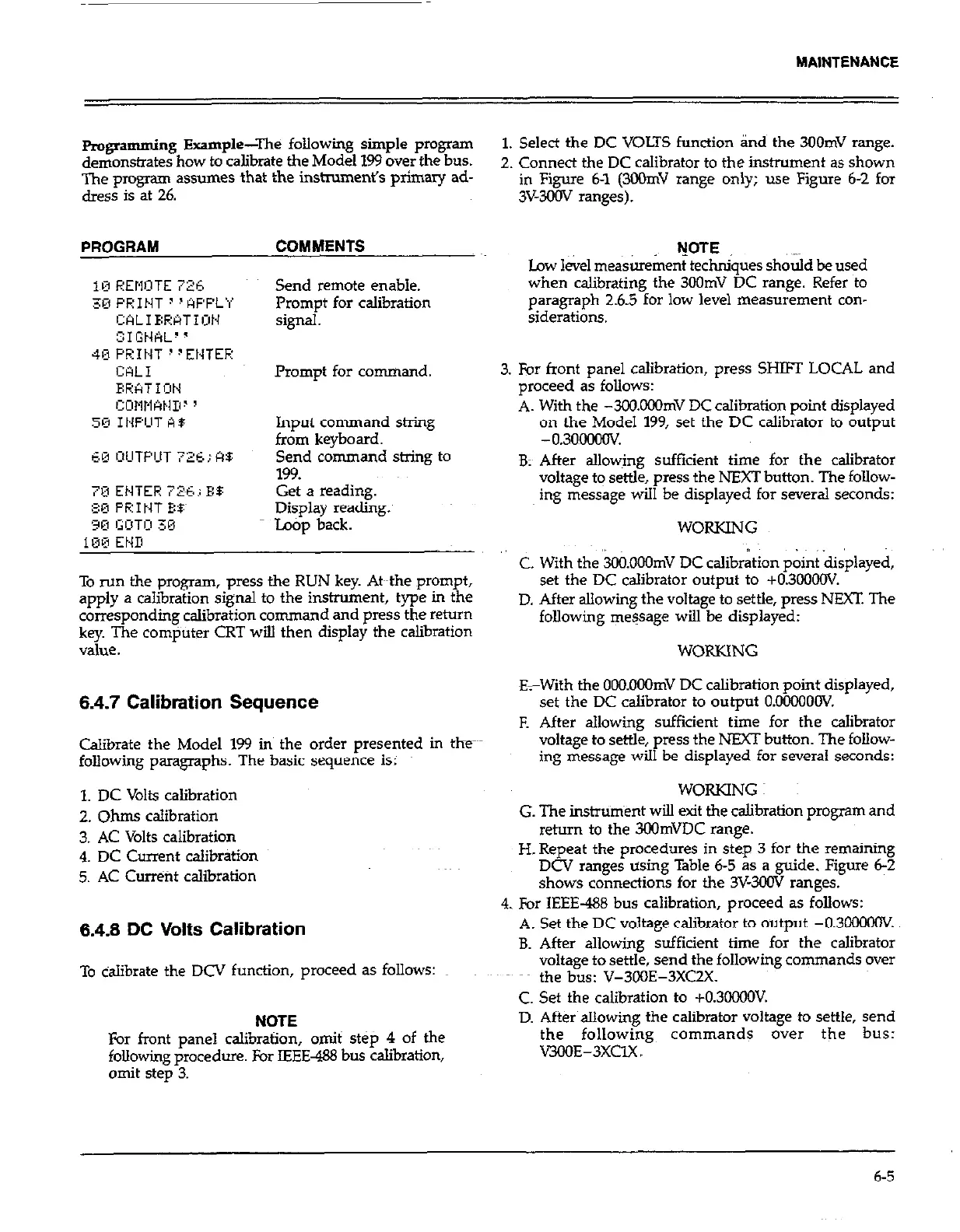Programming Example-The following simple program
demonstrates how to calibrate the Model 199 over the bus.
The program assumes that the instrumenYs primary ad-
dress is at 26.
PROGRAM
COMMENTS
Send remote enable.
Prompt for calibration
signal.
Prompt for command.
Input command string
from keyboard.
Send command string to
199.
Get a reading.
Display reading
Loop back.
To run the program, press the RUN key. At~~the prompt,
apply a calibration signal to the instrument, type in the
corresponding calibration command and press the return
key. The computer CRT will then display the calibration
value.
6.4.7 Calibration Sequence
Calibrate the Model 199 in the order presented in then
following paragraphs. The basic sequence is:
1. DC Volts calibration
2. Ohms calibration
3. AC Volts calibration
4. DC Current calibration
5. AC Currefit calibration
6.4.8 DC Volts Calibration
To calibrate the DCV function, proceed as follows:
NOTE
For front panel calibration, omit step 4 of the
following procedure. For IEEE&3 bus calibration,
omit step 3.
1. Select the DC VOLTS fun~ction and the 3OOmV range.
2. Connect the DC calibrator to the instrument as shown
in Figure 6-l (3OOmV range only; use Figure 6-2 for
3V-3C0V ranges).
NOTE
Low l&l mea&&nent techn$es should be used
when calibrating the 300mV DC range. Refer to
paragraph 26.5 for low level measurement con-
siderations.
For front panel calibration, press SHIFI LOCAL and
proceed as follows:
A. With the -3oo.CKKJmV DCcalibration point displayed
on the Model 199, set the DC calibrator to output
-0.300000V.
8:~ After allowing sufficient time for the calibrator
voltage tq settle, press the NEXT button. The follow-
ing message will be displayed for several seconds:
WORKING
C. With the ‘&K?C@mV DC calibrition point displayed,
set the DC calibrator output to +0300oW.
D. After allowing the voltage to settle, press NEXT. The
following message will be displayed:
WORKING
EIWith the OOO.ooOmV DC calibration point displayed,
set the DC calibrator to output O.OKlOOOV.
F. After allowing sufficient time for the calibrator
voltage to settle, press the NEXT button. The follow-
ing message will be displayed for several seconds:
WORKING :
G. The instrum$nt will exit the calibration program and
return to the 300mVDC range.
H. Repeat the procedures in step 3 for the remaining
DCV ranges using Table 6-5 as a guide. Figure 6-2
shows connections for the 3V-m ranges.
For IEEE-488 bus calibration, proceed as follows:
A. Set the DC voltage calibrator to output -0.3OOOOOV.
6. After allowing sufficient time for the calibrator
voltage to settle, send the following commands over
the bus: V-3@%-3XC2X.
C. Set the calibration to +0.3oooOV.
D. After allowing the calibrator voltage to settle, send
the following commands over the bus:
WE-3XClX.
6-5
